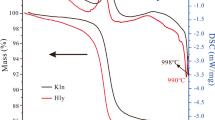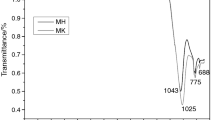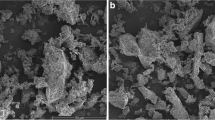Abstract
This work aims to study the pore analysis and the behaviour of the unreacted metakaolin particles in the geopolymer cements from halloysitic and kaolinitic clays. The XRD patterns of the geopolymer cements show the unreacted metakaolin particles at about 21 °(2θ). The micrography images of the specimen from calcined kaolinitic clay confirm the presence of the unreacted metakaolin particles except the one using calcined kaolinitic clay from Bangoua. Whereas those from calcined halloysitic clay are compacts, homogeneous and denser microstructure. The compressive strength of the specimen from calcined halloysitic clay (88.50 ± 2.08 MPa) is higher compared to those from calcined kaolinitic clays (between 45.43 ± 1.84 and 57.20 ± 1.09 MPa). The pore analysis shows that the pore size diameters of the specimen from calcined halloysitic clay are in the range 7.4–16.2 nm while those from calcined kaolinitic clays are ranging from 5.5 to 12.3 nm. It was found that although the geopolymer cement from calcined halloysitic clay contains more unreacted metakaolin particles, it possesses the mesopores due to the inclusion of these fine unreacted metakaolin particles in its structure.
Similar content being viewed by others
Data Availability
All data generated or analysed during this study are included in this article.
References
Cebeci ÖZ (1977) Mercury intrusion porosimetry theory and its application to air-entrained cement pastes and mortars. Iowa State University Capstones, Retrospective Theses and Dissertations. 6061. https://lib.dr.iastate.edu/rtd/6061
Nielsen-Marsh CM, Hedges REM (1999) Bone porosity and the use of mercury intrusion porosimetry in bone diagenesis studies. Archaeomerry 41:165–174
Provis JL, van Deventer JSJ (2009) Geopolymers. Structures, processing, properties and industrial applications. Woodhead Publishing Limited and CRC Press LLC, Boca Raton
Li K, Zeng Q, Luo M, Pang X (2014) Effect of self-desiccation on the pore structure of paste and mortar incorporating 70 % GGBS. Constr Build Mater 51:329–337
Pinson MB, Masoero E, Bonnaud PA, Manzano H, Ji Q, Yip S et al (2015) Hysteresis from multiscale porosity: modeling water sorption and shrinkage in cement paste. Phys Rev Appl 3:1–17
Monteiro P (2006) Concrete: microstructure, properties, and materials. McGraw-Hill Publishing, New York
Zeng Q, Li K, Fen-Chong T, Dangla P (2012) Pore structure characterization of cement pastes blended with high-volume fly ash. Cem Concr Res 42:194–204
Kim J, Choi YC, Choi S (2018) Fractal characteristics of pore structures in GGBFS-based cement pastes. Appl Surf Sci 428:304–314
Mindess S, Young JF, Darwin D (1981) Concrete. Prentice Hall, Englewood Cliffs
Davidovits J (2018) Why Alkali-Activated Materials (AAM) are not geopolymers, technical paper #25, Geopolymer Institute Library. https://www.geopolymer.org. https://doi.org/10.13140/RG.2.2.34337.25441
Elimbi A, Tchakoute HK, Njopwouo D (2011) Effects of calcination temperature of kaolinite clays on the properties of geopolymer cements. Constr Build Mater 25:2805–2812
Guo X, Shi H, Dick WA (2010) Compressive strength and microstructural characteristics of class C fly ash geopolymer. Cem Concr Compos 32(2):142–147
Humad AM, Kothari A, Provis JL, Cwirzen A (2019) The effect of blast furnace slag/fly ash ratio on setting, strength, and shrinkage of alkali-activated pastes and concretes. Front Mater 6. https://doi.org/10.3389/fmats.2019.00009
Zivica V, Palou MT, Bágel TIL (2014) High strength metahalloysite based geopolymer. Compos B 57:155–165
Kaze CR, Tchakouté HK, Mbakop TT, Mache JR, Kamseu E, Melo UFC, Leonelli C, Rahier H (2018) Synthesis and properties of inorganic polymers (geopolymers) derived from Cameroon metahalloysite. Ceram Int 44:18499–18508
Tchakouté HK, Melele SJK, Djamen AT, Kaze CR, Kamseu E, Nanseu CNP, Leonelli C, Rüscher CH (2020) Microstructural and mechanical properties of poly(sialate-siloxo) networks obtained using metakaolins from kaolin and halloysite as aluminosilicate sources: A comparative study. Appl Clay Sci 186:105448
Zhang B, Guo H, Yuan P, Li Y, Wang Q, Deng L, Liu D (2020) Geopolymerization of halloysite via alkali-activation: Dependence of microstructures on precalcination. Appl Clay Sci 185:105375
Kaze CR, Venyite P, Nana A, Juvenal DN, Tchakoute HK, Rahier H, Kamseu E, Melo UC Leonelli C (2020) Meta-halloysite to improve compactness in iron-rich laterite-based alkali activated materials. Mater Chem Phys 239:122268
Zhang Z, Wang H, Yao X, Zhu Y (2012) Effects of halloysite in kaolin on the formation and properties of geopolymers. Cem Concr Compos 34:709–715
Sudo T (1953) Particle shape of a certain clay of hydrated halloysite, as revealed by electron microscope. Min J 1:66–68
Kitagawa Y (1976) Identification of kaolinite and metahalloysite in tropical soils. Jpn Agric Res Q 10:58–62
Hong H, Li Z, Xiao P (2009) Clay mineralogy along the laterite profile in Hubei, South China: Mineral evolution and evidence for eolian origin. Clay Clay Miner 57:602–615
Tchakouté HK, Rüscher CH, Kong S, Ranjbar N (2016) Synthesis of sodium waterglass from white rice husk ash as an activator to produce metakaolin-based geopolymer cements. J Build Eng 6:252–261
Bewa CN, Tchakouté HK, Banenzoué C, Cakanou L, Mbakop TT, Kamseu E, Rüscher CH (2020) Acid-based geopolymers using waste fired brick and different metakaolins as raw materials. Appl Clay Sci 198:105813
Njoya A, Nkoumbou C, Grosbois C, Njopwouo D, Njoya D, Courtin-Nomade A, Yvon J, Martin F (2006) Genesis of Mayouom kaolin deposit (Western Cameroon). Appl Clay Sci 32:125–140
Van Der Marel H (1976) Atlas of infrared spectroscopy of clay minerals and their admixtures. Elsevier, Amsterdam
Barbosa VFF, Mackenzie KJD, Thaumaturg C (2000) Synthesis and characterization of materials based on inorganic polymers of alumina and silica: sodium polysialate polymers. Int J Inorg Mater 2:309–317
Yong SL, Feng D, Lukey GC, van Deventer JSJ (2005) The effect of partially reacted surfaces on the short-range ordering of geopolymeric gels. Geopolymer 2005 Proceedings, 75–78
Fernández-Jiménez A, Palomo A, Sobrados I, Sanz J (2006) The role played by the reactive alumina content in the alkaline activation of fly ashes. Microporous Mesoporous Mater 91:111–119
Al Bakri MAM, Kamarudin H, Omar AK, Norazian MN, Ruzaidi CM, Rafiza AR (2011) The effect of alkaline activator ratio on the compressive strength of fly ash-based geopolymers. Aust J Basic Appl Sci 5:1916–1922
Pengou M, Ngassa GBP, Boutianala M, Tchakouté HK, Nanseu-Njiki CP, Ngameni E (2021) Geopolymer cement – modified carbon paste electrode: application to electroanalysis of traces of lead(II) ions in aqueous solution. J Solid State Electr. https://doi.org/10.1007/s10008-021-04897-y
Sing KS (1984) Reporting physisorption data for gas solid systems with special reference to the determination of surface area and porosity. Pure Appl Chem 57:603–619
Singh A (2001) Creative system in structural and construction Engineering. Proceedings of the first international structural engineering and construction conference, Hnolu, Hawaii, 24–27 January 2001. A.A. Balkema, Rotterdam, Brookfied
Acknowledgements
Dr. Tchakouté Kouamo Hervé gratefully acknowledges the Alexander von Humboldt-Stiftung for its financial support this work under grant N°KAM/1155741 GFHERMES-P.
Funding
The characterization of samples was supported by Pr. Tchakouté Kouamo Hervé under the Alexander von Humboldt-Stiftung under the grant N° KAM/1155741 GFHERMES-P.
Author information
Authors and Affiliations
Contributions
S.J.K. Melele : Validation, Methodology, Writing - review & editing, Visualization, original draft. H.K. Tchakouté: Conceptualization, Methodology, Investigation, Writing - original draft. C. Banenzoué: Conceptualization, Methodology, Investigation, Writing - original draft. E.L. Hseumou: Validation, Writing - review & editing, Visualization. C.P.N. Nanseu: Supervision, Methodology, Resources, C.H. Rüscher: Resources and Supervision.
Corresponding author
Ethics declarations
This manuscript has not been published elsewhere in any form or language and has not been submitted to more than one journal for simultaneous consideration.
Conflict of Interest
No potential conflict of interest was reported by the authors.
Consent to Participate
Not applicable.
Consent for Publication
Not applicable.
Additional information
Publisher’s Note
Springer Nature remains neutral with regard to jurisdictional claims in published maps and institutional affiliations.
Highlights
• Geopolymer cement from calcined halloysitic clay contains more unreacted metakaolin particles.
• It possesses the mesopores due to the inclusion of these fine unreacted metakaolin particles in its structure.
• The unreacted metakaolin particles in the geopolymers from kaolinitic clay do not include in the network.
• The pore size diameters of the geopolymers from calcined halloysitic clay are in the range 7.4-16.2 nm.
• The pore size diameters of the geopolymers from calcined kaolinitic clays are ranging from 5.5 to 12.3 nm.
Rights and permissions
About this article
Cite this article
Melele, S.J.K., Tchakouté, H.K., Banenzoué, C. et al. Pore Analysis and the Behaviour of the Unreacted Metakaolin Particles in the Networks of Geopolymer Cements Using Metakaolins From Kaolinitic and Halloysitic Clays. Silicon 14, 2235–2247 (2022). https://doi.org/10.1007/s12633-021-01021-7
Received:
Accepted:
Published:
Issue Date:
DOI: https://doi.org/10.1007/s12633-021-01021-7




